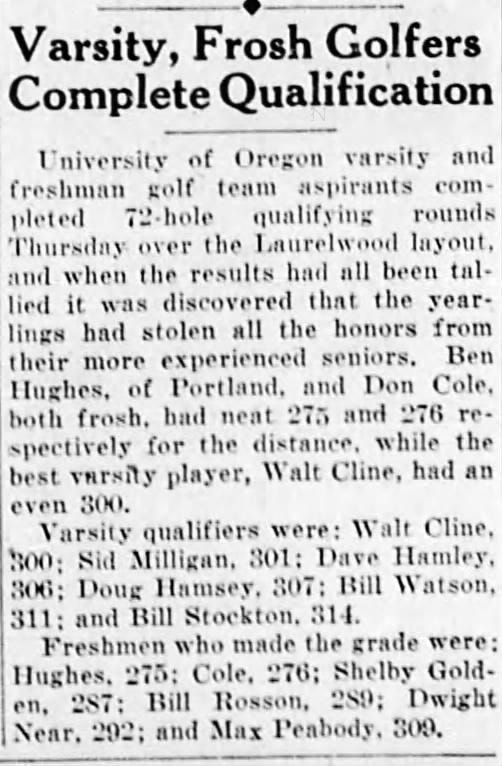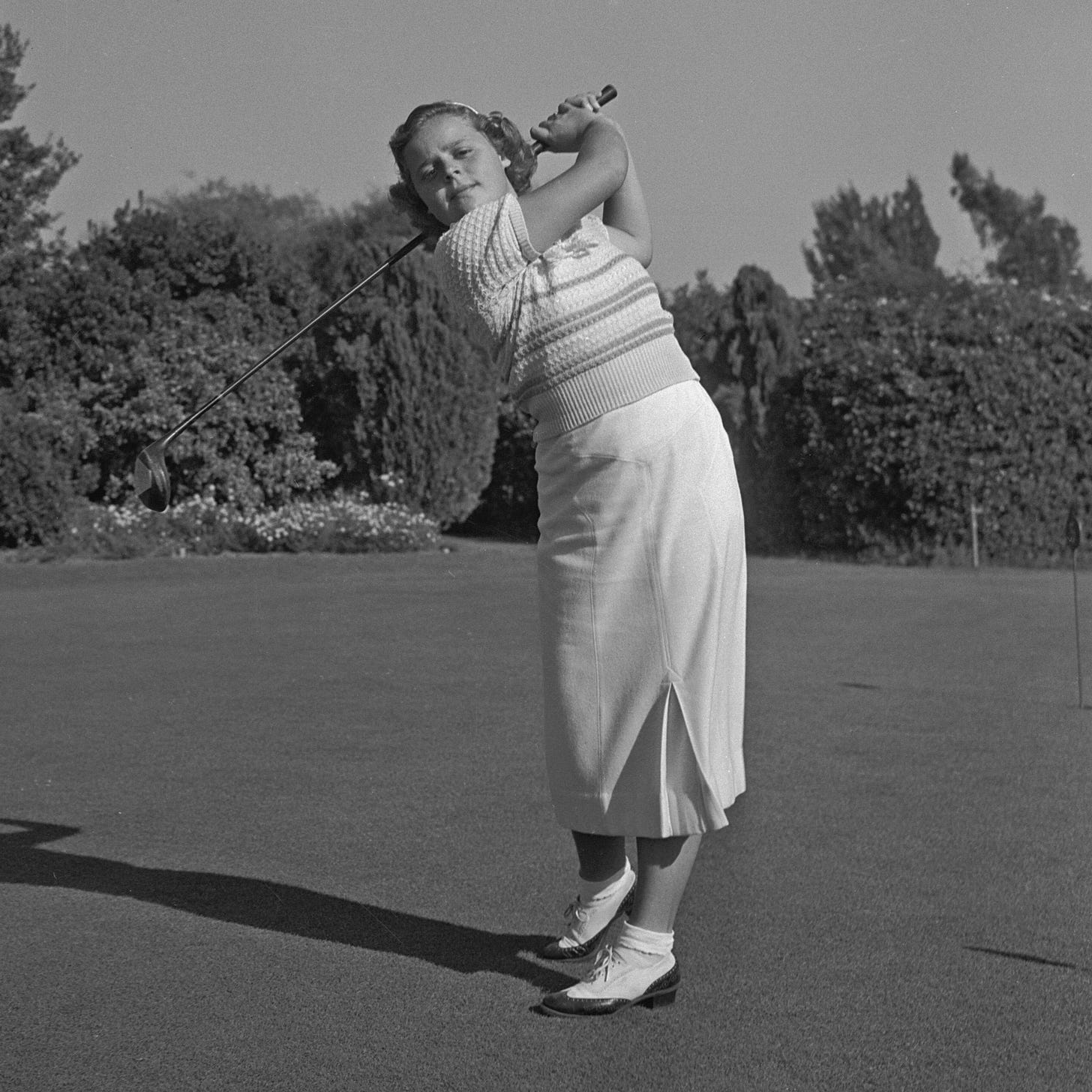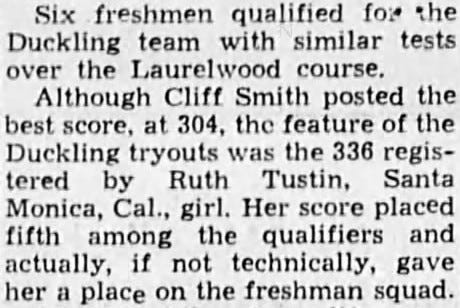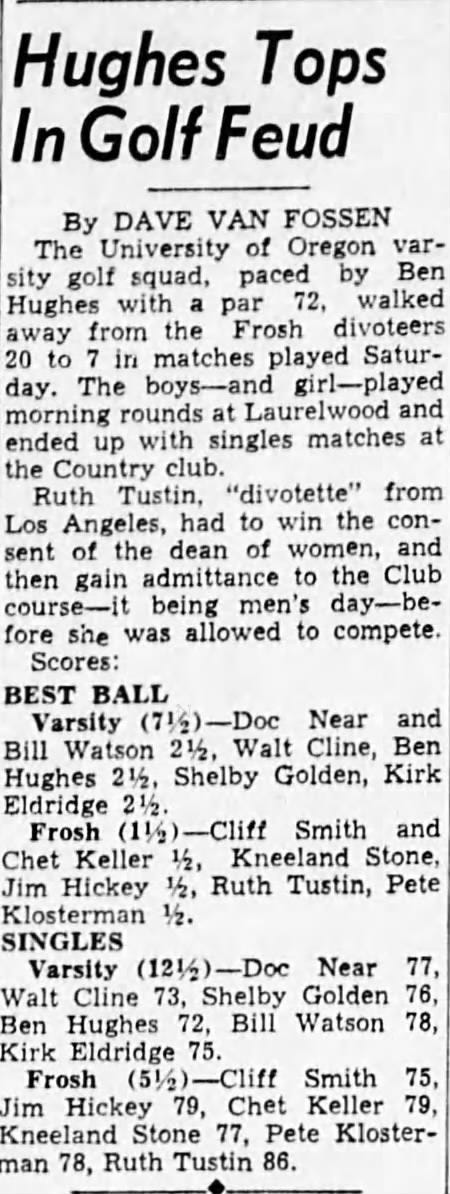1938 OREGON GOLF TEAM: SHELBY GOLDEN AND RUTH TUSTIN BREAK BARRIERS
Shortly before the onset of World War II, golf had reached a point in popularity where colleges throughout the United States were finally adding it to their list of supported “minor” sports. In 1939, the NCAA took over hosting responsibilities for the men’s intercollegiate golf championship - which dated back to 1897 - and within a few years a women’s intercollegiate golf championship was started by the Ohio State Women’s Physical Education department. Amidst the backdrop of African Americans fighting racial bias in collegiate sports (not to mention everyday life) and the intentional non-existence of women’s collegiate athletics, the 1938 Oregon golf program broke multiple barriers as Shelby Golden (varsity) and Ruth Tustin (freshman) earned spots on the team.
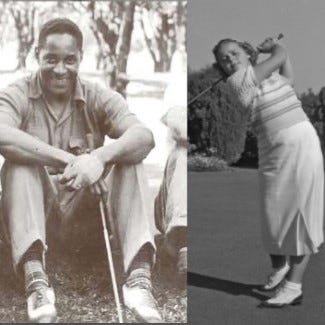
MAIN CHARACTERS
There are many people mentioned throughout, so here are some of the main characters (in alphabetical order) to hopefully provide a quick reference guide, and perhaps better context:
*NOTE 1: underlined text provides a link to references or sites with more information
*NOTE 2: we have done our best to cull out sources that contain problematic language or sentiments, but sometimes those things cannot be helped or are otherwise included to illustrate a point; we hope you understand this usage and recognize its educational purpose is not an endorsement
Shelby Golden - Oregon’s first African American golfer, helped the team win two Pacific Coast Conference (Northern Division) championships. Earned both “minor” and “major” athletic letters
Mack Robinson - Older brother of baseball legend Jackie Robinson. Won multiple track and field titles while at Oregon in 1938, two years after finishing 2nd behind Jesse Owens in the infamous 1936 Berlin Summer Olympic Games
Robert “Bobby” Robinson - Along with Charles Williams, one of the first African American athletes at the University of Oregon, played football (multiple positions) in 1927.
Dorothy Sellars - Incredibly talented female golfer who unofficially competed for the Oregon State (men’s) freshman golf team in a 1938 match against Ruth Tustin
Ruth Tustin - Golf phenom from Los Angeles that made history for being the first woman to earn an athletic award (freshman “numerals”) at the University of Oregon. Possibly the first woman to earn numerals in golf in the entire country
Charles Williams - Shelby Golden’s older half-brother who broke barriers at the University of Oregon a decade before Golden attended. One of the first African American athletes at the University, played football (multiple positions) in 1927.
SHELBY GOLDEN
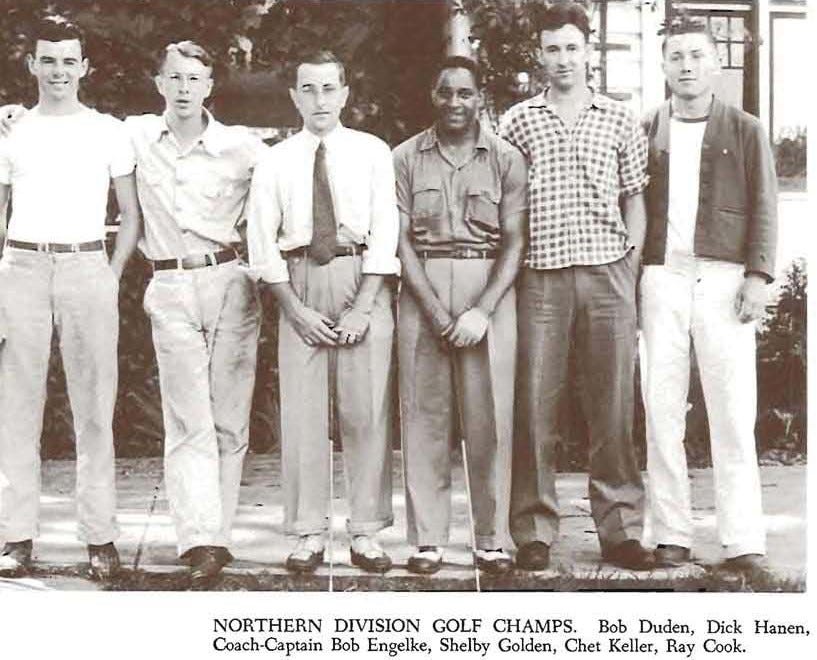
High School Superstar
Shelby Golden was a multi-sport athlete of great renown in the Portland, Oregon area. Along with excelling at the more typical sports of football and basketball, he also managed to gain exceptional skill in golf which was incredibly difficult given the limitations on places to play and practice. In 2014, 80 years after graduating from high school, Golden was inducted into the Portland Interscholastic Hall of Fame. Also inducted that year was Shelby’s half-brother, Charles Williams (Sr), who graduated from Washington High School a full decade before Shelby. As we’ll discuss below, Charles’s impact at Oregon paves the way for Shelby (and countless others) and is a likely reason why his younger half-brother chose the University. Fortunately, we also have a published first-hand account of Shelby’s thoughts on the University:
Making the Golf Team [1937]
The Spring of 1937 marked ten years since Shelby Golden’s half-brother, Charles Williams, and childhood friend Bobby Robinson broke the color barrier in University of Oregon sports by making the football team. Shelby did the same for the golf team that Spring when he made the University freshman team, known as the “Ducklings.” At that time, universities across the country did not allow freshmen to play on their varsity teams, however making the freshman squad in any given sport was considered a huge honor worthy of earning a set of “numerals” (whereas varsity players earned “letters”). As a representative of the freshman squad, Golden played in a series of matches throughout the spring, including against the varsity team and the Oregon State freshman team.
1938-41 Seasons
With only one senior returning for the 1938 season, the Oregon varsity team has several slots open for underclassmen. During their spring qualifier in early March, Golden was one of a trio of sophomores that earned a spot on the varsity team. The young “webfoot” squad won several matches throughout the spring against the likes of Washington, Idaho, College of Puget Sound, and even the University of British Columbia. At the end of the season, Washington barely edged out Oregon at the Pacific Coast Conference Northern Division championship. Although he had participated in a majority of the matches during the season, Golden was not selected as one of the four players to make the trip to the PCC - Northern Division championship. We believe this was due to golf qualification rather than being a racial bias, given the events the following year, but do not yet have definitive research one way or the other.
Golden once again made the Oregon team in 1939 and would go on to have a great season. In an early May match against Washington State, he shared medalist honors with teammates Fred Davis and Dwight Near. Later that month, Shelby made the trip to the PCC - Northern Division championship and helped Oregon win the team title as teammate Ben Hughes took medalist honors. Just 16 years after Northwestern’s Horace McDougal became (likely) the first African American golfer to play in a conference championship, Shelby Golden was now a member of a conference champion team. Given the few conferences officially playing golf at the time, and the even fewer African American college players, this was an incredibly historic accomplishment.
The 1940 season is a bit of a mystery. What should have been Shelby Golden’s senior season was instead apparently a year off. We have yet to find information on what happened during this “lost” year, but will be sure to update when we know more.
Golden returned in 1941 and had another successful season. Not only did he make the trip to the PCC Northern Division championship, he finished as the second best scorer on the team which again took home the team title. Because of their efforts in bringing multiple championships to the school, Golden was among those varsity golfers who received the same letters that “major” sports such as football earned, rather than “O” letters (smaller version) that golf and other “minor” sports typically received.
After School
Despite his success representing a major university sports team and winning multiple conference championships, the reality outside of school was that Shelby Golden was still severely limited on places to play golf due to the color of his skin. He is credited as being one of the players instrumental in creating the Leisure Hour Golf Club in the early 1940s. From the website:
In the early 1940’s very few blacks could be found on public golf courses. Vernon Gaskin sought to remedy this situation by forming an organization to create power in numbers. Others who were instrumental in the formation of Leisure Hour Golf Club were, the late Stephen Wright, Walter & Gladys Ricks and Shelby Golden.
Leisure Hour’s first annual tournament, the “Pacific Northwest Negro Amateur Golf Tournament” was held at Eastmoreland Golf Course in the summer of 1944. It was held there for the next several years. From 1951 to 1966, the tournament was held at the Tualatin Country Club.
After WWII, Shelby continued to live in the same Portland, Oregon area, and enjoyed a long career as a Registered Mail Supervisor in the U.S. Postal Service. He passed away in early 2001.
RUTH TUSTIN
Prior to School
In the mid-1930’s, the talk of the Los Angeles women’s golf scene was young phenom, Ruth Tustin. At the time the above photo was taken in 1935, she was a sophomore at Marlborough School and one of the youngest golf champions of the junior membership at the Wilshire Country Club, located 6 miles northwest of downtown Los Angeles. The next year, she reached the finals of the famously competitive Del Monte (Pebble Beach) Women’s Championship as a 16 year old.
1938 Season
We’re still not exactly sure what brought Ruth to the University of Oregon. Unfortunately, at the time of this writing, there is still a severe lack of information on her life. Regardless of the reason, Tustin’s qualifying for the Oregon freshman golf team is historically significant for both the school and women’s collegiate golf in general. We will cover the state of women’s college golf in the coming Women’s Championship series which will give more context to the time, but as mentioned in another post highlighting Janet Shock earning a varsity letter as a member of the Denison golf team in 1939 (a year from now), women playing on “men’s” golf teams was exceptionally rare.
Tustin didn’t just make the “Duckling” team, she actually played in a couple of match events against men. These weren’t just events for show either, she notched several victories in both singles and doubles matches. The first match of note was against the varsity “Webfoot” team where she and Pete Klosterman gained a half-point in the best-ball match against Shelby Golden and Kirk Eldridge.
The most anticipated matchup for the year, however, was a match against the Oregon State “Rooks” who had their own (unofficial) female teammate, Dorothy Sellars. Unfortunately, Sellars did not get the same official recognition that Tustin did, and is not listed anywhere (including the yearbook) as being an official member of the team. Because of her opponent’s unofficial status, Tustin’s score actually counted for two matches that day as her “official” one was against a male member of the Rook golf squad. Tustin triumphed over Sellars in what was considered by some to be the unofficially-official women’s college golf individual championship (of the region).
As mentioned above, Ruth’s official inclusion on the Oregon freshman “Duckling” squad earned her a set of the coveted numerals. Not only was this historic as being the first “regular athletic award” earned by a female student at Oregon, it’s likely one of the first awarded to a female golfer in the entire country!
Transfer to Arizona
Unfortunately, not much is known about Ruth’s life, including the reason for her transfer the following year to Arizona. She did not enter the first women’s Intercollegiate Golf Championship (hosted by Ohio State), but based on the general lack of western school representation, this is likely due to financials more than anything else. The only other details we have at this time after school in Arizona is her marriage to Tremaine Reynolds, birth of her son Robert Tustin Reynolds Burke, and eventual death in Salem, OR in 2004. We will be sure to come back and update this section when more information becomes available.
BONUS: MORE HAPPENING AT OREGON
Charles Williams and Bobby Robinson

Both Charles Williams - older half-brother of Shelby Golden - and Bobby Robinson faced incredible adversity as the first African American athletes to compete at the University of Oregon (1927). From an article published by the university’s alumni website:
In 1926, the two Portland residents came to Eugene for their academic and athletic pursuits. They were offered full scholarships and recruited by the new Oregon head coach John J. McEwan, an All-American in 1914 at Army.
Both were high school friends and rivals, both were selected First Team All-City their senior years, and both packed the stands at Multnomah Field on gamedays with eager fans fanatically following their athletic performances.
Together, they helped Coach McEwan usher in a new era with the Oregon Webfoots. However, their presence at the university was not fully accepted.
When Robinson and Williams arrived on campus, they were barred from living in the “Whites Only” campus dorms and lived in off-campus apartments during their freshman year.
Historian Herman Brame, BS ’68 (sociology), who wrote the book Forgotten Ducks: The Story of Robinson and Williams, explains that this social situation was not created by the university—but by the state of Oregon.
The dedication and efforts by Robinson and Williams paved the way for generations of Black athletes to shine at the university. For the present and future accomplishments yet to happen at the UO, a debt of gratitude is owed to these two who overcame adversity to be on and off the field.
Mack Robinson

Some might be surprised to learn that Jackie Robinson - one of the most celebrated athletes of all time - had an older brother who was a track and field star at the University of Oregon in the late 1930s. It might also be a surprise to learn that Mack Robinson is an Olympic medal winner, earning silver in the 200m event which Jesse Owens famously won in the 1936 summer games in Berlin. In 1938, competing as an Oregon “Webfoot”, Mack won the NCAA and AAU titles in the 220-yard dash as well as a PCC title in the long jump. From an incredible article published by the university:
“He tried to get my uncle Jack to go there. That’s what I understand. You know when you love a school, you want everybody to go with you. So what I remember is that he loved the school so much that he tried to get my uncle Jack to go there, but UCLA snatched him up right before Oregon could get him.”
-Wayne Robinson, Mack Robinson’s son
1939 NCAA Basketball Champs
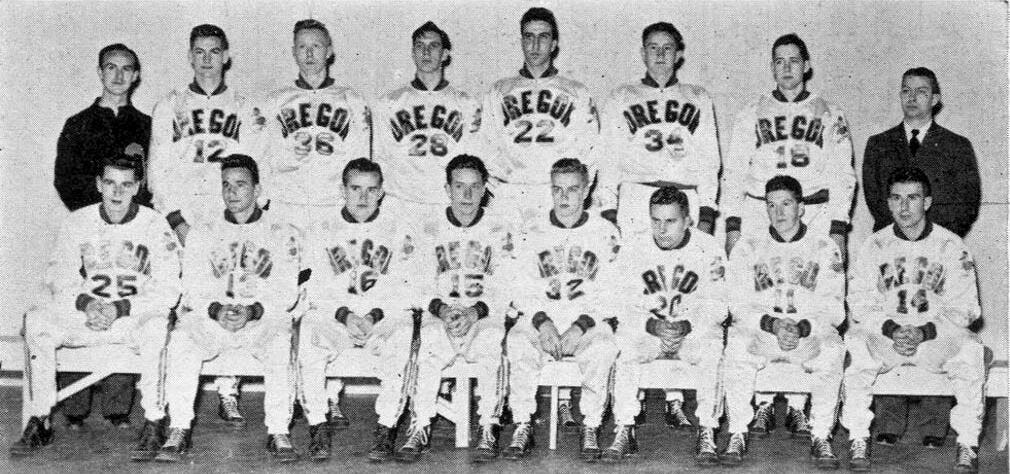
Not only did the NCAA host its first men’s golf championship in 1939, the first recognized NCAA basketball championship (which was actually run by the National Association of Basketball Coaches) was played that year. After a successful season in the PCC, Oregon defeated Texas and Oklahoma in the early-March championship tournament before facing down Ohio State for the title in Northwestern’s Patten Gymnasium. Oregon won 46-33, becoming the first NCAA basketball championship team.






